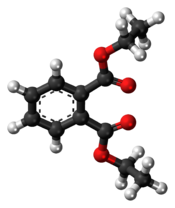Diethyl phthalate
 |
|
 |
|
| Names | |
|---|---|
|
Preferred IUPAC name
Diethyl benzene-1,2-dicarboxylate
|
|
| Other names
Diethyl phthalate
|
|
| Identifiers | |
|
3D model (Jmol)
|
|
| ChEBI | |
| ChemSpider | |
| ECHA InfoCard | 100.001.409 |
| KEGG | |
|
PubChem CID
|
|
| UNII | |
|
|
|
|
| Properties | |
| C12H14O4 | |
| Molar mass | 222.24 g/mol |
| Appearance | colourless, oily liquid |
| Density | 1.12 g/cm3 at 20 °C |
| Melting point | −4 °C (25 °F; 269 K) |
| Boiling point | 295 °C (563 °F; 568 K) |
| 1080 mg/L at 25 °C | |
| log P | 2.42 |
| Vapor pressure | 0.002 mmHg (25°C) |
| -127.5·10−6 cm3/mol | |
| Hazards | |
| NFPA 704 | |
| Flash point | 161.1 °C (322.0 °F; 434.2 K) |
| Explosive limits | 0.7%-? |
| Lethal dose or concentration (LD, LC): | |
|
LD50 (median dose)
|
8600 mg/kg (Rat) |
| US health exposure limits (NIOSH): | |
|
PEL (Permissible)
|
none |
|
REL (Recommended)
|
TWA 5 mg/m3 |
|
IDLH (Immediate danger)
|
N.D. |
|
Except where otherwise noted, data are given for materials in their standard state (at 25 °C [77 °F], 100 kPa).
|
|
|
|
|
| Infobox references | |
Diethyl phthalate (DEP) is a phthalate ester, namely the diethyl ester of phthalic acid. It is a clear substance that is liquid at room temperature and is only slightly denser than liquid water. It has a faint, disagreeable odor and can be transferred from the plastics that contain it. When burned, DEP produces toxic gases.
Since the compound is a suitable solvent for many organic molecules, it is often used to bind cosmetics and fragrances. Other industrial uses include plasticizers, detergent bases and aerosol sprays. Because of the frequent dermal exposure of humans to the chemical, the question of toxicity is crucial. Several studies suggest that DEP can cause damage to the nervous system as well as to the reproductive organs in males and females.
Due to their use as plasticizers, diethyl phthalates are ubiquitous in the environment, especially near places of production and use. Biodegradation through microbially-mediated processes can result in products that can potentially harm microorganisms. There is also general evidence of widespread human exposure. Non-occupational exposure results from the diet, for example phthalate-coated medicines and nutritional supplements, and through consumer products. High occupational exposure was observed in workers directly manufacturing plasticizers. Studies suggest a high correlation between air and urine sample concentrations of short side-chain phthalates such as DEP, making inhalation an important route of exposure.
Diethyl phthalate, or o-Benzenedicarboxylic acid diethyl ester consists of a benzene ring with two carboxylic acid ethyl esters attached to it in the ortho (1,2) pattern. It is a highly conjugated system, as the pi-cloud on the benzene ring, the p-orbitals on the carbonyl atoms and the lone pairs on the oxygens are all conjugated. The substituents are meta-directing, and they are ortho to each other, so all positions in the ring are more or less equally deactivated. Diethyl phthalate is likely to undergo biodegradation in the environment. Abiotic degradation processes such as hydrolysis, oxidation, and photolysis are unlikely to play significant roles in the environmental fate of diethyl phthalate.
...
Wikipedia

